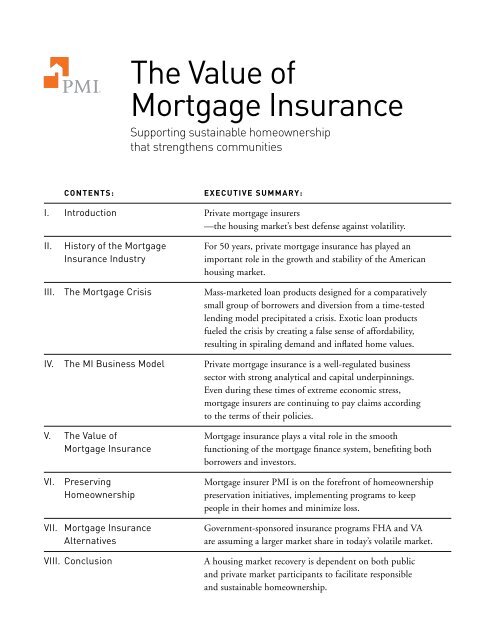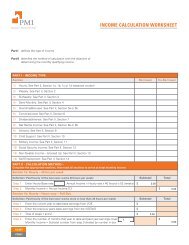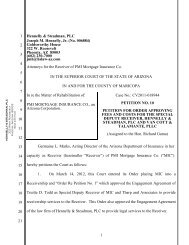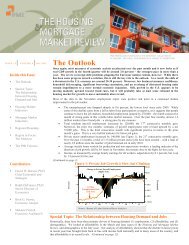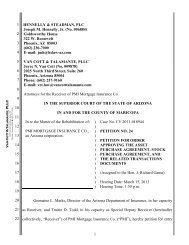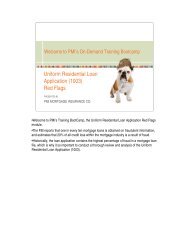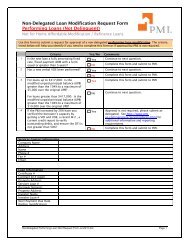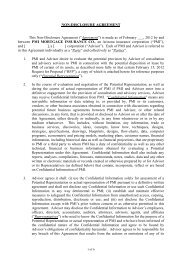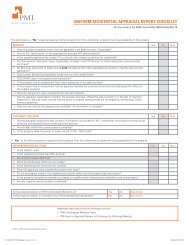The Value of Mortgage Insurance - PMI Group, Inc.
The Value of Mortgage Insurance - PMI Group, Inc.
The Value of Mortgage Insurance - PMI Group, Inc.
Create successful ePaper yourself
Turn your PDF publications into a flip-book with our unique Google optimized e-Paper software.
T h e V a l u e o f M II. Introduction<strong>Mortgage</strong> insurance has played an important role in the mortgage finance system for nearly halfa century. This little-known segment <strong>of</strong> the insurance industry provides vital support to the U.S.housing market, a critical component <strong>of</strong> the American economy. As a key support to lenders,borrowers and investors, mortgage insurance is <strong>of</strong>ten misunderstood relative to its role in managingmortgage risk and as a catalyst for sustainable homeownership.<strong>The</strong> desire to create healthy, sustainable homeownership is at the heart <strong>of</strong> the values that drive themortgage insurance industry. <strong>Mortgage</strong> insurers work closely with lenders and investors acrossthe country to design loan products and underwriting guidelines with the goal <strong>of</strong> both helpingborrowers achieve homeownership and supporting long-term success. A simplistic explanation<strong>of</strong> the mortgage insurance industry’s value proposition is that it enables qualified borrowers topurchase homes with less than the traditional 20% down payment by sharing the mortgage riskwith the lender. This gives lenders the confidence to make loans that otherwise would be viewedas high risk, and at the same time, helps creditworthy borrowers achieve homeownership earlier.A few years ago, the mortgage industry moved away from traditional lending practices andmortgage insurance was <strong>of</strong>ten replaced by riskier products such as ”piggyback” loans. <strong>The</strong> marketexpanded aggressively without the discipline that mortgage insurers traditionally applied. Now, themortgage industry is the epicenter <strong>of</strong> the global economic meltdown. While the mortgage insuranceindustry has not escaped the impact <strong>of</strong> the financial crisis, it is doing exactly what it was designedto do - paying valid claims. Today, the mortgage insurance industry is absorbing billions <strong>of</strong> dollarsin losses due to home foreclosures, losses that would otherwise flow through Fannie Mae, FreddieMac, and other mortgage investors. <strong>The</strong>se losses are being absorbed by private capital, not taxpayerfunds. Unlike other private risk counterparties, the capital structure <strong>of</strong> mortgage insurers - requiredby state insurance regulation and rating agencies – provides the necessary reserves that have allowedmortgage insurers to continue paying claims during this most challenging <strong>of</strong> times.Steve Smith, Chairman and CEO <strong>of</strong> <strong>PMI</strong> <strong>Mortgage</strong> <strong>Insurance</strong> Co., said, “Nobody called this one 100percent right. <strong>Mortgage</strong> insurers are taking major losses and there is no guarantee that all <strong>of</strong> the playerswill be here when this crisis is over. But what I also know to be true is that a vibrant housing marketdepends on sustainable homeownership. Private mortgage insurers are the housing market’s best defenseagainst volatility because we’re invested in – and we pr<strong>of</strong>it from – healthy, sustainable growth. It’s in ourbest interest to make sure the borrower, the mortgage broker, the lender and the investor are successful.”2
T h e V a l u e o f M IPrivate MI’s place in the origination processBorrower<strong>Mortgage</strong> Lender takes applicationLender reviews applicationagainst investor and mortgage insurance guidelines.Loan approved or declined.Borrowerwith 20% downNon-delegatedLenderDelegatedLenderLender sends fileto mortgage insurancecompany for underwritingSends electronicapproval file to MI.MI sends an immediateresponse withcertificate numberLender sellsmortgage or pool <strong>of</strong>mortgages to investor(Secondary Market)Investor issues security backed by mortgages3
T h e V a l u e o f M I<strong>The</strong> True Borrowing CostInitial loanamount:$350,00030-Year Fixed@5%30 YR FixedMonthly payment$1,879*Interest Onlyfor 5 yearsInterest fully amortizing Onlyat year 6Fully-indexed paymentInitial monthly payment$1,458$2,046**Option ARM<strong>Mortgage</strong>with 1% TeaserOption ARMFully-indexed paymentInitial monthly payment$1,166$2,083***0 500 $1,000 1000 $1,500 1500 $2,000 2000 $2,500 25000 $000* Payment based on 30-year, fixed-rate, fully amortizing loan.** Payment based on 5% interest-only payment through year 5. At year 6, assumes fully amortizing5% fixed rate, 25-year term.*** Assumes initial payment based on 1% teaser rate, annual payment adjustments can not exceed7.5% <strong>of</strong> prior period payment and $6,369 <strong>of</strong> deferred interest.<strong>The</strong> seemingly limitless availability <strong>of</strong> financing also served to fuel home price appreciation. Inmany parts <strong>of</strong> the U.S., home prices increased by more than 20 percent in 2004 alone. <strong>The</strong>y wereup by 25 percent in California, Florida and a few other areas.Today, the mortgage industry has returned to fully documented income and assets, standard loanproducts, and improved quality control and underwriting practices. <strong>The</strong> data show a clear swingaway from exotic loan products and back to traditional first mortgages with some type <strong>of</strong> mortgageinsurance, either private or government-sponsored. <strong>The</strong> <strong>Mortgage</strong> Bankers Association (MBA)reported in July <strong>of</strong> 2008 that fixed-rate loans made up 63.6 percent <strong>of</strong> first mortgages in the secondhalf <strong>of</strong> 2007, compared to 53.4 percent in the first half <strong>of</strong> that year. Only 7.5 percent <strong>of</strong> originationswere for non-prime loans, compared with 10.4 percent for the first half <strong>of</strong> 2007. Alt-A fell to 7.8percent from 15.8 in the first half <strong>of</strong> 2007. In addition, the MBA reported that almost 80 percent<strong>of</strong> all origination dollars were for prime loans, compared with 70 percent in the first half <strong>of</strong> 2007.8
T h e V a l u e o f M IAs the nation struggles with the impact created by exotic loan products, one fact is clear: the privatemortgage insurance industry continues to perform, paying valid claims and, at the same time,continuing to play an important role in making homeownership a reality for millions <strong>of</strong> Americans.During this severe economic downturn, private mortgage insurers are also making significantcontributions to preventing foreclosures.IV. <strong>The</strong> MI Business Model<strong>The</strong> challenges facing mortgage insurers only serve to validate the industry’s underlying strength,derived from a strong regulatory framework and rigorous third-party scrutiny. State insuranceregulators require mortgage insurers to hold significant contingency reserves and meet stringent riskto-capitalratios. <strong>The</strong>se capital standards are extremely demanding, both in terms <strong>of</strong> the minimumcapital required to become an industry participant and the ongoing requirements. In addition, ratingagencies apply an equally stringent stress test to mortgage insurers’ portfolios before issuing ratings.Laws governing mortgage insurance require adequate capital relative to the risk insured, and stateinsurance regulators monitor to ensure there are funds available to back the risk and pay claims forthe protection <strong>of</strong> policyholders and the public. <strong>Insurance</strong> regulators examine quarterly financialstatements and company operations to ensure sufficient capital is available to pay claims evenduring periods <strong>of</strong> severe economic stress. Because mortgage insurers are in first-loss position on lowdown payment mortgages, their operations are carefully scrutinized.Another unique feature <strong>of</strong> mortgage insurance is the contingency reserve. Essentially, the contingencyreserve exists to store away premium dollars during good times so that reserves are available to payclaims during downturns. State insurance law requires mortgage insurers to set aside 50 cents fromevery premium dollar earned and hold it for 10 years. However, these contingency reserves maybe released with the approval <strong>of</strong> the state insurance regulator in any year in which the mortgageinsurer’s loss ratio (losses as a ratio <strong>of</strong> premiums earned during a reporting period) exceeds 35percent. <strong>The</strong>se kinds <strong>of</strong> loss ratios are usually seen only during high-stress loss periods, such as thecurrent environment.<strong>The</strong> reserves are released exclusively to pay claims, and only to the extent to which the loss ratioexceeds 35 percent. <strong>The</strong> rationale <strong>of</strong> this regulation is that contingency reserves are built upduring good times when borrower defaults and claims are relatively low, and drawn down duringdifficult times when claims are high. In addition, insurance regulations severely restrict the types <strong>of</strong>9
T h e V a l u e o f M Iinvestments in which reserves can be held, thereby encouraging mortgage insurance premiums toreflect the risks they are intended to cover and discouraging speculative investing.Rating agencies, such as S&P and Moody’s, are also conscious <strong>of</strong> the potential market volatilitythat mortgage insurance companies must absorb. <strong>The</strong> rating agencies’ 10-year stress test is basedon a tumultuous environment similar to the Great Depression, assuming a continuous, nationwidedepression-like economy lasting for a full decade. As a further check on the adequacy <strong>of</strong> mortgageinsurers’ capital levels, rating agencies, regulators and the mortgage insurance companies themselveshave developed models that subject the mortgage insurer’s portfolios to simulated 10-year stressscenarios. <strong>The</strong>se models rely on actual loan performance data from past periods <strong>of</strong> severe housingstress, such as the “Oil Patch” crisis in Texas and Oklahoma in the mid-1980s and the early 1990sdefense industry closures in Southern California.<strong>The</strong> combination <strong>of</strong> the capital requirements and the 10-year contingency reserves, minimum riskto-capitallevels imposed by state mortgage insurance regulations, and the 10-year stress modelsdeveloped by the mortgage insurers and rating agencies, have all led to continued claims-payingabilities. Unlike companies that issued unregulated insurance contracts, such as Credit DefaultSwaps (with none <strong>of</strong> the reserve requirements and scrutiny outlined above), mortgage insurance isdesigned to better protect policy holders during times <strong>of</strong> extreme economic stress.Common Misperceptions<strong>Mortgage</strong> insurance is not a particularly well-known industry—let’s look at some <strong>of</strong> the commonmisunderstandings.Perception:<strong>Mortgage</strong> <strong>Insurance</strong> isn’t tax-deductible.Reality: Borrower-paid mortgage insurance became deductible in 2007 for borrowers withannual incomes up to $109,000. Depending on incomes and other eligibility criteria, todayborrowers can deduct up to 100% <strong>of</strong> the cost <strong>of</strong> mortgage insurance premiums on their federalincome taxes 1 . <strong>The</strong> original law was extended for three years, effective for mortgages issued afterDecember 31, 2006 and before January 1, 2011. It does not apply to mortgage insurance policiesin place prior to the legislation’s passage. Some industry experts anticipate that Congress will extendthe deduction or make it permanent.1 Subject to restrictions under the Internal Revenue code. Taxpayers should consult their own tax advisers concerningthe applicability <strong>of</strong> the deduction to their particular circumstances under applicable tax codes.10
T h e V a l u e o f M IPerception:Borrowers are stuck with mortgage insurance payments for as long as they own their home.Reality: Most lenders permit borrowers to cancel borrower-paid mortgage insurance bydemonstrating that they have a loan-to-value <strong>of</strong> 80 percent or less with the condition that theborrower has a good payment history. In addition, under federal law, mortgage insurance must becancelled automatically when the borrower has paid the loan down to 78 percent <strong>of</strong> the originalvalue.Perception:Borrowers receive no benefit from mortgage insurance.Reality: Borrowers benefit by having mortgage insurance as it allows the lender to make a loanwith less than a 20% down payment, which permits borrowers to buy a home sooner and startbuilding equity. Additionally, if the homeowner is delinquent, the institution servicing the loanmay rely on the mortgage insurance company as a resource to help work through various options toavoid foreclosure.Perception:Having mortgage insurance on a loan delays the approval process and is generally a hassle for theborrower.Reality: As the mortgage industry has evolved, so have mortgage insurance companies. <strong>Mortgage</strong>insurers now <strong>of</strong>fer delegated approval authority to most lenders, electronic processing <strong>of</strong> mostapplications, and a choice <strong>of</strong> payment options to meet different needs.Perception:When times are tough, mortgage insurance companies find ways to avoid paying claims.Reality: <strong>Mortgage</strong> insurers are careful to ensure claims are fairly reviewed and that all validclaims are paid according to the terms <strong>of</strong> the policy. In 2008, <strong>PMI</strong>’s US mortgage insuranceoperations paid over $800 million in claims, versus $362 million in 2007.In reality mortgage insurance is beneficial to both lender and borrower. For that reason, SusanWachter, a finance pr<strong>of</strong>essor at the Wharton School at the University <strong>of</strong> Pennsylvania, urgesborrowers to “consider mortgage insurance, which can help them obtain a single, low downpayment mortgage without any unnecessary added risk.”11
T h e V a l u e o f M IV. <strong>The</strong> <strong>Value</strong> <strong>of</strong> <strong>Mortgage</strong> <strong>Insurance</strong>Despite the current financial turmoil, mortgage insurance continues to play a vital role in helpingto ensure the smooth functioning <strong>of</strong> the mortgage finance system.Working with Lenders to Help Borrowers• <strong>Mortgage</strong> insurance works for the borrower. In a troubled market, the interests <strong>of</strong> mortgageinsurers may align with all parties – servicers, mortgage insurers and borrowers – work proactivelyto avoid foreclosure. <strong>The</strong> mortgage insurer has a direct interest in engaging with both theborrower and lender to prevent default and mitigate a potential claim payment. Unlike loanservicers that must serve many constituents – bond trustees, investors and borrowers – mortgageinsurers have a targeted focus: keeping borrowers in their homes to avoid claims. <strong>Mortgage</strong>insurance companies working directly with loan servicers have the latitude to directly makedecisions to support loan modifications, or advance a portion <strong>of</strong> a claim possibly avoidinga foreclosure, and keeping borrowers in their homes.Depth <strong>of</strong> Expertise• As monoline insurers, mortgage insurance companies may only write mortgage insurance policies.With this exclusive focus comes a thorough understanding <strong>of</strong> mortgage risk. Unfortunately, overthe past few years many participants entered the mortgage field that didn’t have the same depth<strong>of</strong> expertise and appreciation for risk. New players like the Wall Street investment banks broughtcreative, but untested risk “management” and dispersion methods. Complex structured financevehicles promoted by investment banks, such as CDOs (Collateralized Debt Obligations), leftanonymous investors around the world saddled with risk for which they had little appreciationor understanding.Keeping the System Functioning• <strong>Mortgage</strong> insurers help stabilize markets by taking a first-loss position. Acting as a shock absorber,mortgage insurers add stability to the mortgage finance system by allowing the transfer <strong>of</strong> somerisk out <strong>of</strong> the banking and financial system into the insurance markets. <strong>The</strong> essence <strong>of</strong> insuranceis the transfer and dispersion <strong>of</strong> risk. <strong>Mortgage</strong> insurers are the first line <strong>of</strong> defense to keep thesystem running smoothly by putting private capital at risk.With Fannie Mae and Freddie Mac currently under federal conservatorship, the mortgageinsurance industry is also serving as a buffer between losses that ultimately would flow to thetaxpayers by continuing to pay claims due to the GSEs.12
T h e V a l u e o f M IBringing Innovation to <strong>Mortgage</strong> Finance• <strong>Mortgage</strong> insurance is a force <strong>of</strong> innovation. Through competition, the market benefits fromhaving several mortgage insurance firms with different strengths bring new ideas to the mortgagefinance system.• An example <strong>of</strong> this innovation is <strong>PMI</strong> <strong>Mortgage</strong> <strong>Insurance</strong> Co.’s development <strong>of</strong> the cuttingedgeAutomated Underwriting Risk Assessment (AURA) system to better assess and quantify thecombined risk associated with a borrower’s credit pr<strong>of</strong>ile and geographic real estate risk.VI. Preserving Homeownership“Devastating things happen to families when they lose their homes,” says David Katkov, ChiefBusiness Officer <strong>of</strong> <strong>PMI</strong> <strong>Mortgage</strong> <strong>Insurance</strong> Co. “For homeownership to be successful, it hasto be sustainable.” Katkov adds, “Our work in loss mitigation and homeownership preservationbenefits our policyholders and shareholders, but it’s also vital to sustaining the fabric <strong>of</strong> our society.If you travel to some <strong>of</strong> these communities, as I have, you can see how devastating foreclosures canbe. Some <strong>of</strong> these neighborhoods only have one occupied home on the entire street; the rest arevacant and <strong>of</strong>ten vandalized. Vacant properties become blighting influences on the neighborhoods,driving down values <strong>of</strong> the remaining occupied homes. <strong>The</strong> few families struggling to hang on tothe homes they worked so hard for can quickly find themselves living in an abandoned, dangerousneighborhoods. <strong>The</strong>re is simply no upside to having people lose their homes.”John Jelavich is Vice President <strong>of</strong> Homeownership Preservation Initiatives (HPI) at <strong>PMI</strong>, managingthe HPI team that reaches out to lenders and borrowers to try to find creative solutions to keepborrowers in their homes.“Think <strong>of</strong> a funnel as the infrastructure that the lenders’ servicers have in place to help peoplein trouble with their mortgages. When these defaults started flooding in, the funnel just wasn’tbig enough to catch everything,” Jelavich said. “We’re invested in the success <strong>of</strong> these loans, sowe’re very strategic about how we can help our customers prevent more foreclosures and rescuehomeowners who otherwise might have slipped through the cracks.”13
T h e V a l u e o f M IOne effective effort, initiated by <strong>PMI</strong>, is the placement <strong>of</strong> loss mitigation representatives in the<strong>of</strong>fices <strong>of</strong> lenders’ loan servicing centers. This allows HPI members to see where bottlenecks mightbe developing and quickly develop solutions to smooth them out.Because <strong>of</strong> the increasing number <strong>of</strong> problem loans, lenders’ servicing staff are spread thin.Jelavich says, “Today, to ensure that loans with <strong>PMI</strong> coverage receive needed attention, we ask ourcustomers if we can help. <strong>The</strong> cost to service a deliquent loan is huge. By providing assistance, wehave better control over the ultimate disposition <strong>of</strong> <strong>PMI</strong>-insured loans.”Jelavich describes unique workouts that are only available on loans insured with mortgageinsurance. “Let’s say a borrower is five-months delinquent. But he’s back on his feet and hascorrected the reason for the default. <strong>The</strong>se are typically the borrowers we can help with something<strong>PMI</strong> developed in the early ‘80s called the Saving Homeownership and Repayment Program(SHARP).” SHARP is one <strong>of</strong> many programs <strong>PMI</strong> has implemented to minimize losses in thecurrent crisis.“In some cases, we may advance a portion <strong>of</strong> our claim in the form <strong>of</strong> a loan to the borrower,which covers missed payments and penalties,” Jelavich says. “That stops the foreclosure and lets theborrower keep their home. <strong>The</strong>n we work with the borrower to repay this claim advance througha zero-interest note with very flexible payment terms. If that borrower eventually defaults, what weadvanced is netted out <strong>of</strong> the lender’s ultimate claim.”“We recently helped a borrower trying to avoid foreclosure who had done all <strong>of</strong> the right things. He’dhanded in all the right paperwork and was simply waiting to hear from his lender. In a routine followup,we learned that the lender had not received his pay stubs and had begun foreclosure proceedings.<strong>The</strong> borrower had no idea. We stepped in, had him resubmit his pay stubs, and followed up to makesure they arrived at the lender’s <strong>of</strong>fice. All it took were three phone calls to save this man’s house andavoid a needless claim. We also saved our lender/customer from having to take over and sell the property.”<strong>PMI</strong> was also the first mortgage insurer to become a member <strong>of</strong> the Hope Now Alliance organizedby Financial Services Roundtable, comprised <strong>of</strong> top U.S. lenders, servicers, and mortgage insurers.“Right now, we’re participating in community outreach events around the country to help troubledborrowers. Although we can’t directly modify loans with borrowers to prevent a foreclosure, thelenders have to do that, but we provide on-site logistical support. We also invite borrowers to attendthese events through direct mail, phone calls and outreach to local media.”14
T h e V a l u e o f M IVII. <strong>Mortgage</strong> <strong>Insurance</strong> AlternativesFHA LoansFHA insurance generally covers mortgages that require smaller down payments and employsmore flexible guidelines when assessing the borrower creditworthiness. Among other things, FHAprograms allow financing a portion <strong>of</strong> closing costs and the upfront mortgage insurance premium.With lenders and mortgage insurers tightening guidelines and raising prices, the FHA is taking alarger share <strong>of</strong> the housing market. Citing a report from Inside <strong>Mortgage</strong> Finance, <strong>The</strong> Wall StreetJournal noted that FHA’s share <strong>of</strong> new insured mortgages has jumped from a low <strong>of</strong> 1.8 percent in2006 to 23 percent in July 2008. Many private market investors are concerned about future lossesin the housing market and are leery <strong>of</strong> lending money for new high loan-to-value mortgages, letalone refinance those in trouble. <strong>The</strong>refore the FHA is being asked to do more, such as providingrefinancing options for those homeowners hardest hit by the mortgage and credit crisis, creatingsignificant exposure to the taxpayer.Some experts, such as Douglas Elmendorf, a Senior Fellow at the Brookings Institution, gavestrong support to the FHA in testimony to the U.S. Senate Committee on Banking, Housing andUrban Affairs in April 2008. He said, “First, the FHA’s traditional mandate is to assist individualsunderserved by the traditional mortgage market, and it has many years <strong>of</strong> experience doing so.Given the pullback in private mortgage lending and securitization, it is natural to increase theFHA’s role as a counterweight.”However, the FHA’s growing influence is not without controversy. Economist Ann Schnare,a former executive at Freddie Mac, wrote in a column for Reuters.com in August 2008, “<strong>The</strong>mortgage market, we now know, is risky business. With billions <strong>of</strong> taxpayer money at stake, isit really wise to ask the FHA – chronically underfunded, buffeted by the whims <strong>of</strong> politicians,delegated too little authority – to succeed where they (GSEs) have failed?” Schnare, as have others,notes that the “FHA is light years behind the (mortgage) industry in its management systems, andits ability to attract and retain qualified staff.”VA LoansMuch like the FHA, the Veterans Administration does not make loans. Instead, it guarantees orinsures loans as a benefit to those having served in the US Armed Forces. In some cases, a borrowercan receive a VA-insured loan <strong>of</strong> more than $350,000 while making no down payment. Applicantsmust have an acceptable credit rating.15
T h e V a l u e o f M IGlossary <strong>of</strong> TermsAppraised <strong>Value</strong> – <strong>The</strong> fair market value an appraiser assigns to a particular property, based on hisknowledge, experience, and analysis <strong>of</strong> the property in question, and the market conditions in thearea.ARMs (Adjustable Rate <strong>Mortgage</strong>s) – A mortgage loan or deed <strong>of</strong> trust which allows the lenderto periodically adjust the interest rate in accordance with a specified index.A-Quality Loans – Loans with credit scores <strong>of</strong> 680 and greater and fully documented income andassets.Alt-A Loans – A loan that has certain characteristics such as reduced or no documentationconcerning the borrower’s income, assets, deposit information and/or employment.Credit Default Swap (CDS) – A form <strong>of</strong> credit protection, where the seller <strong>of</strong> the swap guaranteesthe creditworthiness <strong>of</strong> the product. Under this contract, the risk <strong>of</strong> default is transferred from theholder <strong>of</strong> the security to the seller <strong>of</strong> the swap. For example, the buyer <strong>of</strong> a credit swap is entitledto the par value <strong>of</strong> the bond by the seller <strong>of</strong> the swap, should the bond default. <strong>The</strong>se contractshave significantly less regulation and capital requirements as compared to activities <strong>of</strong> mortgageinsurance companies.Default – <strong>The</strong> non-payment <strong>of</strong> a mortgage or other loan in accordance with the terms as specifiedin the note.Fannie Mae/Freddie Mac (Government Sponsored Enterprises – GSEs) – <strong>Mortgage</strong> investorscreated by the U.S. government to support the mortgage purchase and securitization programs. Bypurchasing mortgages, these entities provide lenders with the cash to make additional loans.FICO score – <strong>The</strong> most widely known type <strong>of</strong> credit score used in the United States. FICO scoresrange from 300 to 850 with 60% <strong>of</strong> scores between 650 and 799. <strong>The</strong> median score is approximately720 (half <strong>of</strong> scores above and below) and the average credit score is approximately 678.Foreclosure – A legal procedure in which a mortgaged property is sold in a legal process to pay theoutstanding debt in case <strong>of</strong> default.17
T h e V a l u e o f M IInterest Only Loans – Loans that do not reduce principal during the initial deferral period (usuallybetween two and ten years) and, therefore, do not accumulate equity through loan amortizationduring the initial deferral period.<strong>Insurance</strong> in Force (IIF) – <strong>The</strong> current principal balance <strong>of</strong> all outstanding mortgage loans withinsurance coverage as <strong>of</strong> a given date.Less-than-A Quality Loans – Generally loans with credit scores <strong>of</strong> 619 or below.Loan to <strong>Value</strong> (LTV) ratio – <strong>The</strong> ratio <strong>of</strong> the amount <strong>of</strong> the loan to the appraised value or salesprice <strong>of</strong> real property (expressed as a percentage).New <strong>Insurance</strong> Written (NIW) – <strong>The</strong> original principal balance <strong>of</strong> all loans that receive newprimary mortgage insurance coverage during a given period.Payment Option ARMs (Negative Amortization Loans) – Loans that provide the borrower an optionevery month to make a payment consisting <strong>of</strong> principal and interest, interest only, or an amountestablished by the lender that may be less than the interest owed.Piggyback loan – Loan in which the buyer takes a first mortgage to finance part <strong>of</strong> the value <strong>of</strong> theproperty and a second mortgage to finance another part <strong>of</strong> the property’s value. <strong>The</strong> two mortgagestogether are called a piggyback loan.Pool <strong>Insurance</strong> – Insuring a collection <strong>of</strong> mortgage loans with coverage that pays after any primarycoverage. Pool coverage is usually accompanied by a stop-loss which limits the aggregate policyexposure; and may include per incident coverage limits, as well as a deductible. Pool insurance maybe used in tandem with primary mortgage insurance or may be placed on loans that do not requireprimary insurance.Primary <strong>Insurance</strong> – <strong>Mortgage</strong> insurance placed on a loan-by-loan basis and providing first-losscoverage.Risk in Force (RIF) – <strong>The</strong> aggregate dollar amount <strong>of</strong> the current principal balance <strong>of</strong> each insurer’smortgage loans multiplied by the insurance coverage percentage specified in the policy.18


